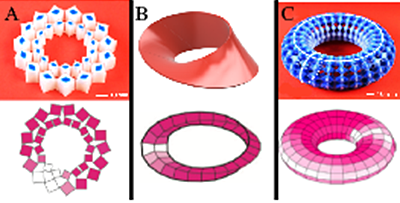Publication of the Physics Laboratory in the journal Nature on June 14, 2023. Communication of the CNRS-INP on June 14, 2023.
A research team involving members of the Physics Laboratory of ENS de Lyon has demonstrated the existence of a new form of order never before identified in nature: 'non-orientable' order, which can endow simple structures with properties that enable them to store information. This work is published in the journal Nature.
Abstract
From atomic crystals to animal flocks, the emergence of order in nature is captured by the concept of spontaneous symmetry breaking. However, this cornerstone of physics is challenged when broken symmetry phases are frustrated by geometrical constraints. Such frustration dictates the behaviour of systems as diverse as spin ices, confined colloidal suspensions and crumpled paper sheets. These systems typically exhibit strongly degenerated and heterogeneous ground states and hence escape the Ginzburg–Landau paradigm of phase ordering. Here, combining experiments, simulations and theory we uncover an unanticipated form of topological order in globally frustrated matter: non-orientable order. We demonstrate this concept by designing globally frustrated metamaterials that spontaneously break a discrete Z2 symmetry. We observe that their equilibria are necessarily heteregeneous and extensively degenerated. We explain our observations by generalizing the theory of elasticity to non-orientable order-parameter bundles. We show that non-orientable equilibria are extensively degenerated due to the arbitrary location of topologically protected nodes and lines where the order parameter must vanish. We further show that non-orientable order applies more broadly to objects that are non-orientable themselves, such as buckled Möbius strips and Klein bottles. Finally, by applying time-dependent local perturbations to metamaterials with non-orientable order, we engineer topologically protected mechanical memories, achieve non-commutative responses and show that they carry an imprint of the braiding of the loads’ trajectories. Beyond mechanics, we envision non-orientability as a robust design principle for metamaterials that can effectively store information across scales, in fields as diverse as colloidal science, photonics, magnetism and atomic physics.

Credits - Xiaofei Guo, Marcelo Guzman, David Carpentier, Denis Bartolo, Corentin Coulais
Reference: Non-orientable order and non-commutative response in frustrated metamaterials. Xiaofei Guo, Marcelo Guzman, David Carpentier, Denis Bartolo, Corentin Coulais. Nature, June 14, 2023.
DOI: 10.1038/s41586-023-06022-7
arXiv: 10.48550/arXiv.2111.13933






